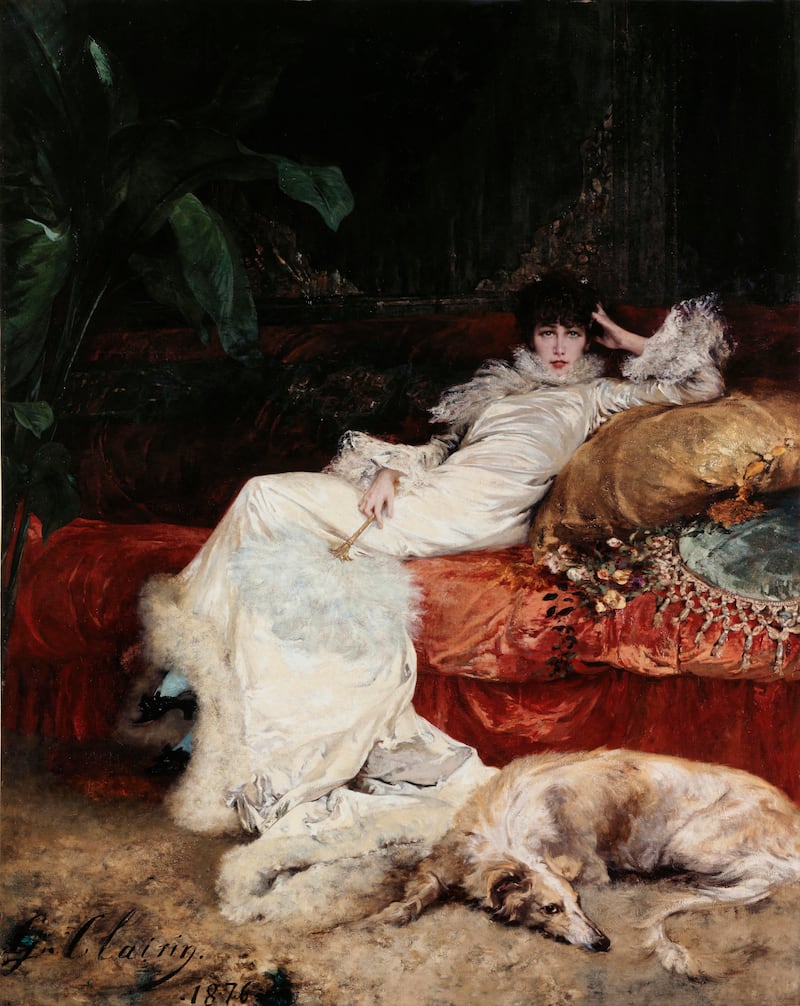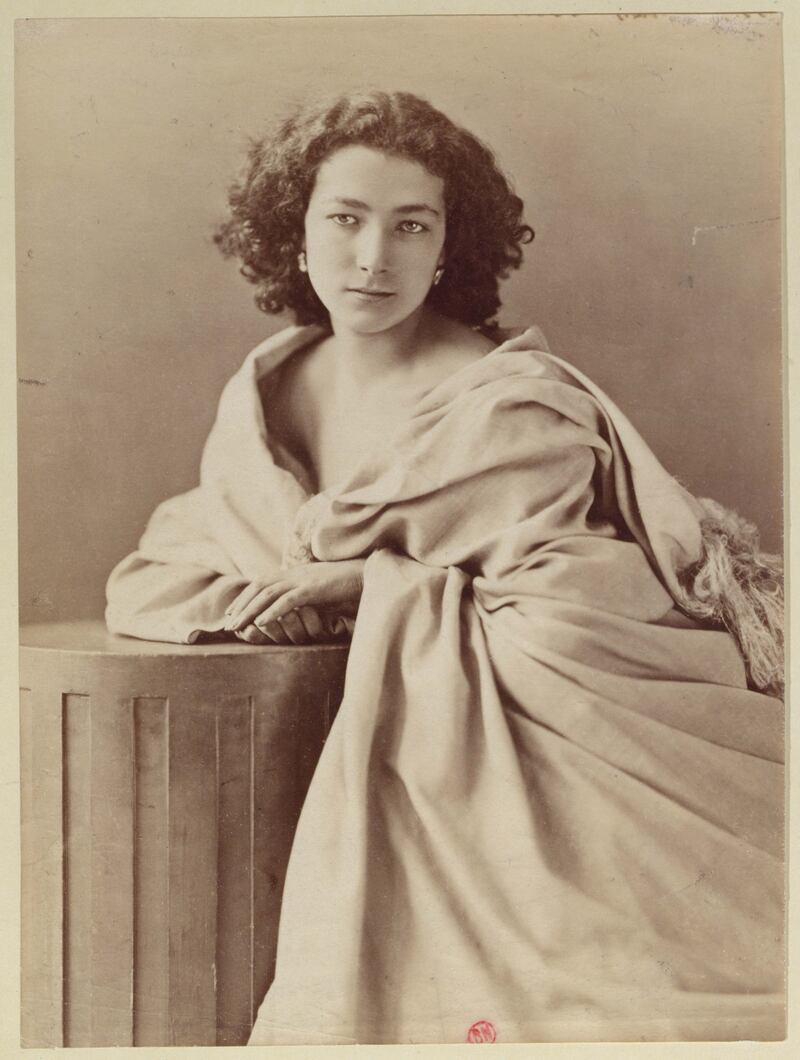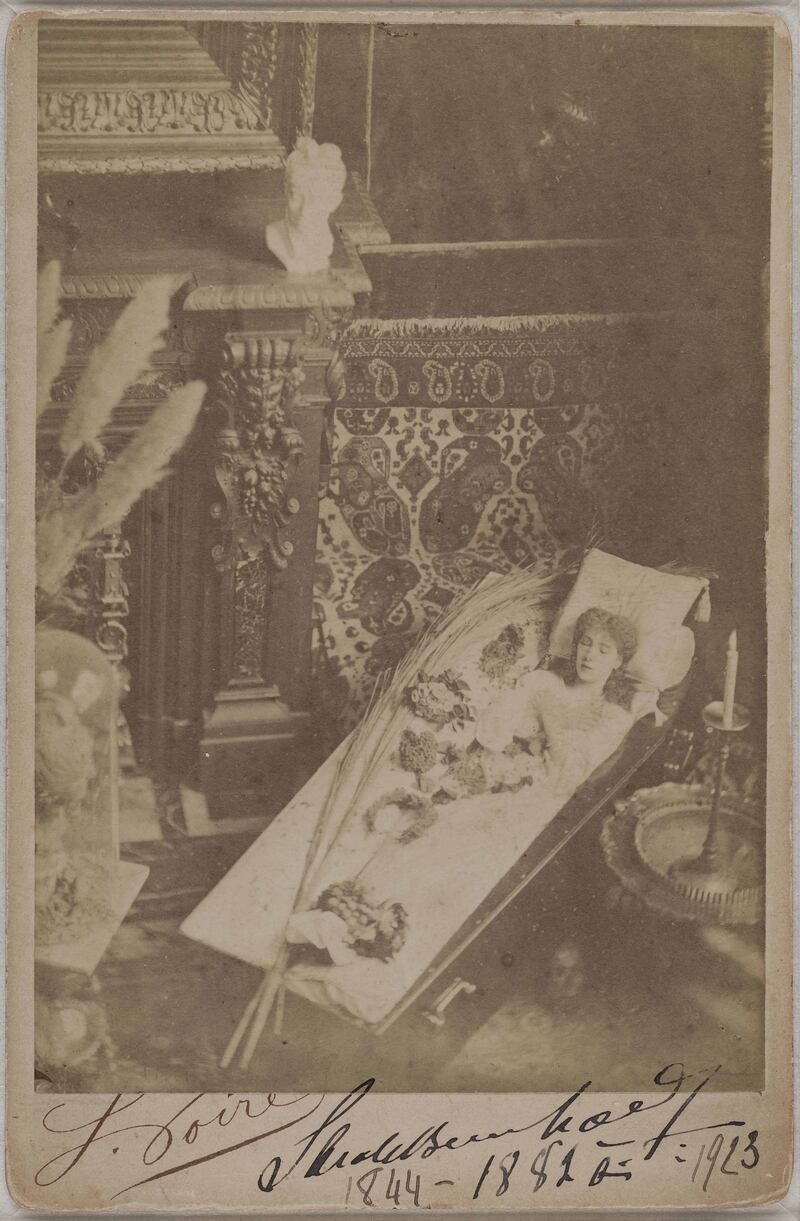She was the most famous actor of the late 19th and early 20th centuries, not just in Belle Époque Paris, but the world over. Sarah Bernhardt toured the US seven times, as well as Canada, Latin America, Australia and Russia.
One hundred years after her death, Bernhardt remains a legend. “Sarah Bernhardt was the first star in history,” says Annick Lemoine, the director of the Petit Palais Museum in Paris. “She was the precursor of Greta Garbo, Marilyn Monroe, Madonna and Beyoncé. She was an influencer before her time, a politically engaged citizen, and a fashion idol.”
The Petit Palais is paying tribute to Bernhardt, who was known as La Grande Sarah, La Divine and Notre Dame du Théâtre, with a superb exhibition until August 27th. On display are more than 400 items including photographs, paintings, Bernhardt’s clothing, theatre costumes, jewellery, and personal possessions, as well as the Art Nouveau posters which she commissioned from the Czech painter Alphonse Mucha.
The exhibition also celebrates a less-known side of Bernhardt: her parallel career as a talented sculptor and painter.
New homes: comprehensive guide to what’s for sale in Dublin, Wicklow, Kildare, Meath, Cork and around the State
‘They’re supposed to represent us, not sue us’: Crafts council threatens members after critical feedback
If Robert De Niro no longer feels he is able to speak out, one wonders who in the US does
When Hollywood stars pose languidly on a day bed, they are channelling Sarah Bernhardt. Each time an entertainer takes a political stand, he or she is following in the footsteps of Bernhardt, who actively supported her country in the Franco-Prussian and first World Wars, sided with Émile Zola on behalf of Alfred Dreyfus, befriended the “Red Virgin” Paris Commune leader Louise Michel, and stood up for the rights of third-class passengers on the ocean liners that carried her across the Atlantic.
Bernhardt’s first stint at the Comédie Française came to an abrupt end when she slapped a rival actor, calling her a cow
A century before Tina Turner, Bernhardt was a survivor who triumphed over adversity, through energy, talent and hard work. While still a child, she adopted the words quand-même, despite all, as her motto. I will live. I will succeed. Despite all, she said.
Her mother ignored her. Bernhardt filled the void of a loveless childhood by smothering her son Maurice with adoration. Her extravagant lifestyle left her deeply indebted. Bernhardt abandoned the Comédie Française, founded her own troupe and commanded huge fees in the US.

At the age of 71, Bernhardt’s right leg was amputated after an injury sustained onstage. She could not adapt to a prosthesis, and had to be carried, in her words “like a Byzantine empress” on a sedan chair for the rest of her life. That did not stop her acting in theatres, in the trenches of the first World War for the benefit of the poilus, and in early motion pictures.
Bernhardt was born in Paris in October 1844. Her mother Judith, also known as Julie or Youle, was a Jew from Amsterdam. Like Bernhardt’s aunt Rosine, and Bernhardt herself for a time, Judith was a kept woman. Charles, Duke of Morny, half-brother of Emperor Napoleon III, was a benefactor and perhaps lover to all three women.
[ Review: Wilde’s Women, by Eleanor FitzsimonsOpens in new window ]
After years in convent school, which her mother never visited, Bernhardt wanted to become a nun. The Duke of Morny said the 15-year-old girl should instead study acting at the conservatory. Félix Nadar took an iconic photograph of Bernhardt then, wrapped in a sheet, looking sensuous and pensive, with intense eyes and a thick mane of black hair.
In those days, the paid mistresses of aristocrats, politicians and affluent men were referred to as cocottes, courtesans or demi-mondaines, rather than prostitutes. Sarah Bernhardt’s name and photograph appeared in the police register of demi-mondaines. The comings and goings of older men and members of parliament from her apartment were painstakingly recorded.
“A lot of actresses started their careers this way,” says Stephanie Cantarutti, co-commissioner of the exhibition. “Actresses were paid very little, and it was the only way to survive.”
The identity of Bernhardt’s father was established with certainty only last year. He was Edouard Viel, a disgraced attorney from Le Havre, who fathered four children out of wedlock with four different women and served a prison sentence for fraud.

Inadequate males were a recurring pattern in Bernhardt’s life. At the age of 19, she had an affair with Henri de Ligne, a Belgian prince who fathered her only child, Maurice. The prince never recognised Maurice, who gambled and proved incapable of managing the theatres Bernhardt purchased. In 1882, Bernhardt married Jacques Damala, a handsome Greek diplomat 12 years her junior. He turned out to be a drug addict and womaniser. The couple separated, but Bernhardt was distraught when Damala died of a drug overdose in 1889. She sculpted a beautiful funerary bust which today belongs to the Metropolitan Museum of Art in New York.
Conservative groups in the US opposed Bernhardt’s visit, saying she was debauched and would corrupt American men
Bernhardt’s first stint at the Comédie Française came to an abrupt end when she slapped a rival actor, calling her a cow, because the other woman had harmed Bernhardt’s little sister.
Bernhardt became known in the theatre world as Mademoiselle Révolte. She eventually found work at the Odéon theatre, where she triumphed as the queen in Victor Hugo’s Ruy Blas in 1872. Victor Hugo called her “the golden voice” and kneeled before her onstage at the premiere.
The Comédie Française begged Bernhardt to return, which she did, for five years. She resigned in an angry dispute over a play she hated, sent copies of her resignation letter to French newspapers, and never paid the 100,000 francs fine for breach of contract.
[ Wilde about Paris – An Irishwoman’s Diary about Oscar Wilde’s life in exileOpens in new window ]
Bernhardt arrived in New York with 48 suitcases which took three days to clear US customs. She had by that time established a reputation for eccentricity. On Bernhardt’s calling card was a photograph of herself lying in her mahogany coffin, with eyes closed and hands crossed on her chest. She claimed she rehearsed her lines and slept in the casket, which travelled with her.
Conservative groups in the US opposed Bernhardt’s visit, saying she was debauched and would corrupt American men. Bernhardt was nonetheless a sensation, performing 156 times in 50 cities. Men threw jewels onto the stage for her. She crossed the continent in a bespoke Pullman railway car, which is reproduced in the Paris exhibition.
In the US, Bernhardt performed Racine’s Phèdre and Dumas’s Dame aux Camélias in a language most of her audience could not understand. Her gestures and body language were sufficient. The same talent would make her a star of silent movies. Her 1912 film Queen Elizabeth was so profitable that it financed the founding of Paramount Pictures.
Neighbours of her Paris townhouse complained of wild animal noises after Bernhardt bought a leopard from the Liverpool zoo
Bernhardt’s life was “astonishingly modern”, the critic Joelle Gayot wrote in Le Monde. She was a devoted single mother, a “cougar” who late in life took a lover 30 years her junior, and gender fluid. Though she had numerous male lovers, Bernhardt’s most enduring relationship was with the painter Louise Abbéma. She often played male characters – Hamlet, Lorenzaccio and Pierrot, among others – because, she said, male parts had better lines. Her tall, slender build made it possible for her to wear male costumes.
George Clairin, another admirer and lover, painted Bernhardt 25 times. She kept for the rest of her life Clairin’s 1876 portrait, in which she leans back seductively on cushions, with an Afghan hound at her feet. Her son Maurice gave it to the Petit Palais, and it is known as the museum’s Mona Lisa.

Many of the tales about Bernhardt’s outrageous behaviour involved her menagerie. Neighbours of her Paris townhouse complained of wild animal noises after Bernhardt bought a leopard from the Liverpool zoo. She walked around with a dinosaur-like lizard on her shoulder, and kept a pet alligator called Ali Gaga, which was said to have died of cirrhosis of the liver from drinking too much champagne. Her boa constrictor choked on a cushion at her holiday home. A pet lion club created a scandal by ravaging hotel suites in the US.
Bernhardt was often the butt of anti-Semitic jokes. Twenty years after her death, during the Nazi occupation of Paris, the Théâtre Sarah Bernhardt was renamed Théatre de la Ville
Bernhardt knew and worked with the great playwrights of her time: Alexandre Dumas, Victor Hugo, Edmond Rostand, Sacha Guitry. Marcel Proust’s lover, the composer Reynaldo Hahn, wrote a book about her. She inspired the character of La Berma in Proust’s In Search of Lost Time. Oscar Wilde wrote Salomé for her.
In 1900, when she was aged 56, Bernhardt played Napoleon Bonaparte’s doomed son, L’Aiglon, who was supposed to be 20. The play was an absolute triumph, clocking up more than 1,000 performances.
Bernhardt was often the butt of anti-Semitic jokes. Twenty years after her death, during the Nazi occupation of Paris, the Théâtre Sarah Bernhardt was renamed Théatre de la Ville. It will be rechristened for her when it opens after renovations in September.
Bernhardt’s long, melodramatic death scenes were famous. On March 26th, 1923, Bernhardt was shooting Sacha Guitry’s film La Voyante when she died, age 78, in her son Maurice’s arms, of kidney failure. In theatres across Paris, curtains fell in mid-performance. Everyone knew what it meant.
La Grande Sarah had died thousands of times onstage. This time, it was real. Marshal Ferdinand Foch, the commander of allied forces in the first World War, was the first to pay homage before her casket. She had nursed Foch when he was wounded in 1870. Five floats laden with flowers and hundreds of thousands of mourners followed her hearse to Pere Lachaise cemetery.
The exhibition, Sarah Bernhardt: And the woman created the star, is at the Petit Palais in Paris until August 27th




















